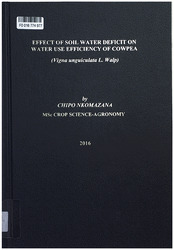| dc.description.abstract | There is a global concern over the capacity to feed a rapidly growing world population against a background of climate change which challenges productivity of major crops such as cowpea and their ability to ensure food security in the future. Cowpea in Botswana is widely grown in the Kalahari Desert and the hardveld in the Eastern region where it is exposed to drought stress during development due to low and uneven rainfall. Such conditions require crops which can efficiently make use of the available water. A field study was conducted from December 2014 to May 2015 at the Botswana University of Agriculture and Natural Resources, Sebele to determine the effect of soil water deficit on water use efficiency and its association with plant morphology and grain yield in cowpea. The experimental design was a randomized complete block design (RCBD) with two treatment factors: water (irrigated and rainfed) and six cowpea genotypes, replicated four times. The six genotypes were also evaluated for rainfall use efficiency (RUE) in the Kalahari Desert-Hukuntsi under a randomized complete block design (RCBD) with four replications. Data was collected on plant height, stem diameter, canopy spread, days to flowering and maturity, leaf area, leaf area index, specific leaf area (SLA) and plant water status; relative waler content (RWC) and percent plant survival. Grain yield (GY) and its components (number of pods per plants, pod length, number of seeds per pod, 100 seed weight, harvest index, biomass) as well as water use (WU) and water use efficiency (WUE) were evaluated at harvest. However,.WUE was also determined at anthesis. Water deficit treatment reduced the mean WU by 80% causing significant (P0.0001) reductions in biomass and grain yield. Reductions in above ground biomass and grain yield were due to a decline in leaf area and its related traits as well as yield components, while high RWC of leaves was maintained in some genotypes which had more survival. Cowpea genotypes varied significantly on WUE; rainfed genotypes were more efficient than the irrigated types both in above ground biomass and grain yield WUE. The results showed that at flowering, WUE was high and decreased with maturity. At maturity WUE ranged from 0.43 to 3.15 kg ha’ mm’1 and 1.65 to 17.32 kg ha'Imm’1 for grain yield and above ground biomass respectively. RUE values were also higher than WUE under rainfed conditions. BCA 001 and BCA 019 were the most water use and rainfall use efficient genotypes in terms of grain production while for above ground biomass, BCA 009 was the most efficient. The strong and significant correlations between WU and RWC with WUE indicate that high WUE was largely due to lower water use and maintenance of plant water status as opposed to yield gain. Crops selected for higher WUE under water deficit conditions should therefore have lower water use and be able to maintain yield. | en_US |

